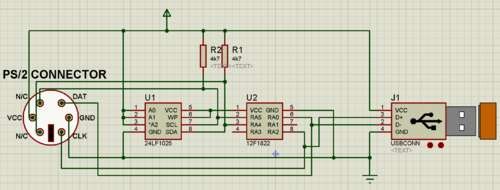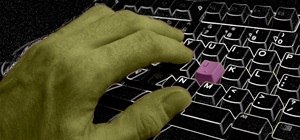Keyloggers are a must-have tool in your arsenal. Hardware keyloggers have the advantage of being undetectable through anti-virus or other protection programs. They also capture keystrokes before the OS even boots up, so they are pretty handy tools.
The only issue with these tools are the price tags. Most of them cost more than $80 USD to purchase. In today's Null Byte, let's make one for (almost) free. There are tons of electronic component stores online that will send us small parts for free!
Requirements
- PIC 12F1822 (SOIC) and EEPROM chips (Free sample here)
- EEPROM 24XX1025 (SOIC) (Free sample here)
- (x2) 4k7 resistor 1/8 W. Get it from your local Radio Shack.
- Pickit 2 / 3. Also can be found at Radio Shack.
- A USB to PS/2 converter
- Low wattage soldering iron
- Steady soldering hand
Downloads
Step 1 Circuitry

The adapter, which connects the GND and VCC pin of the PS/2 connector with their respective pins on the USB Connector and CLK and DAT, pin to, respectively, D+ and D- pins. The other zone is composed by the PIC and the EEPROM. The PIC takes care of detecting incoming raw signals from the PS/2 port, decodes them, and then writes it to the EEPROM, which we will then read from.
Step 2 Open the USB to PS/2 Adapter
Open it up and simply connect pins from the USB female connector to the PS/2 male connector. Just join them at these points:
VCC -> VCC
GND-> GND
D+ -> CLK
D- -> DAT

Solder each wire to a pin on the USB, as shown above. Solder the PIC to the EEPROM, with the resistors properly soldered. After soldering, re-assemble the device and connect it to the keyboard that you want to test it on.
When data has been captured, you must read the EEPROM. If you have soldered the SDA and SCL pin to the two N/C pins of the PS/2 adapter, as it was shown in the circuit diagram, you can now build a simple converter PS/2 to ICSP connector to read your EEPROM or use the Pickit 2.
See the documentation of your programmer to see exactly how to build it.
After you read the EEPROM, you need to open it in a hex editor to view the logs and convert them by code. It's quite easy from this point. I would think there are even programs floating around on the web to convert them, and if not, the codes are easy enough to convert, in which you could make a script yourself...any takers?
Be a Part of Null Byte!
Just updated your iPhone? You'll find new emoji, enhanced security, podcast transcripts, Apple Cash virtual numbers, and other useful features. There are even new additions hidden within Safari. Find out what's new and changed on your iPhone with the iOS 17.4 update.
























9 Comments
nice!!! these are things of beauty, nice circuit diagram too!
Awesome tut, but how does it actually work? I know you said that PIC collects raw signals and sends them to EEPROM for reading, but again for those of us who are hardware impaired, what is a PIC, how does it collect raw signals, what are the raw signals it collects, and how do we end up with keys pressed at the end?
I'm asking for the hows, not the what's. TYVM :)
Well, a PIC is a type of microcontroller, and I don't know much more. They can send the data from the keyboard to the EEPROM, which would basically memorize what data was meant to go through the computer. Meaning, you have an exact replica of all keypresses, and that can be decoded later into text form.
Yeah, pretty much says it all.
I think taking my digital systems course is going to be very helpful for understanding this..
Unfortunately the PS/2 connection has nearly died out , so putting it to use may become tricky. But still awesome tutorial.
USB to PS/2 hardware :D!
I want to make a PS/2 to USB converter, plz let me know the pinouts(working) as here in my place i am unable to find one.
mail me at akagrawal306@gmail.com
i know this is 6 years old so i don't really expect a response but i was wondering the point of the PS/2 to USB part instead of a USB to USB
Share Your Thoughts